| |
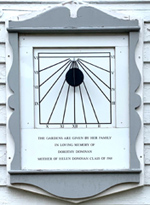 |
South Hadley |
Massachusetts |
USA |
Vertical Dial |
Dial 995 |
| This vertical dial is a quaint and simple sundial made of wood. It is nearly square in shape with hour lines radiating from the gnomon. The hours are marked at the edge of the square in small Roman numerals. There are no solstice or equinox lines. The black disk on the dial face is the base of the gnomon. |
| |
| |
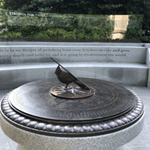 |
Richmond |
Virginia |
USA |
Horizontal Dial |
Dial 994 |
| A large circular plaza holds 7 life sized bronze statues of influential Virginia women during the last 400 years. The plaza will eventually feature 5 more life-size bronze statues. Dedicated in Oct 2019 this monument is a work in progress with other women still to be recognized. In the center of the plaza on a wide circular granite pedestal is a bronze horizontal sundial. In addition to the normal dial furniture of compass rose, inscriptions, site latitude & longitude, and a chapter ring with the hours from 5am to 7pm there is additional information: points of interest in Virginia shown around the dial in the outer chapter ring. Each location is listed by name, azimuth, and distance from the Capitol site. Underneath the style of the gnomon is a bronze Northern Cardinal, the state bird of Virginia. |
| |
| |
 |
Cincinnati |
Ohio |
USA |
Analemmatic Dial |
Dial 993 |
| This analemmatic sundial is laid out in brick. The walkway consists of an inlaid brass analemma surrounded by month indicators for where to stand etched in brick. The analemmatic ellipse is brass, etched with time marks every 15 minutes. Just to the inside and outside of the ellipse are the hours in standard and daylight savings time. Brass indicators are inlaid for the Bailey Points to show the of time and direction of sunrise and sunset. At the edge of the circular brick plaza are granite markers of the cardinal points. |
| |
| |
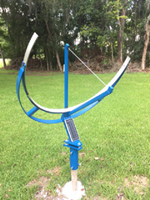 |
Breaux Bridge |
Louisiana |
USA |
Equatorial Dial |
Dial 992 |
| This is a simple but well designed equatorial dial made of a steel frame and 4-foot diameter aluminum equatorial band. This time band can be loosened from its frame and rotated to an equation of time offset position that's based on solar noon according to dates on a placard fixed to the base. When adjusted, the dial shows time to within a minute. The 10-minute time marks and Arabic hour numbers used vinyl numbers and strips as cover during sand-blasting of the aluminum time band. The vinyl was removed leaving the reflective and polished marks and numbers against the grainy sanded aluminum. (This process was first done on a test piece five years earlier and placed it in direct sunlight - no signs of deterioration or coloring. So this is a relatively easy and permanent alternative to chemical etching). Attention is given to alignment with the base adjusted in azimuth and the dial adjusted with a set of three-point latitude and skew alignment bolts. This dial is an excellent study in functional design. According to the builder, "It was a real fun project. Getting it designed and properly setup was challenging. It has given me a keen appreciation for what it must have taken to build some of the great dials around the world!" |
| |
| |
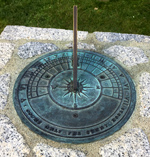 |
Nanaimo |
British Columbia |
Canada |
Horizontal Dial |
Dial 991 |
| This is a beautiful but standard mass-produced dial, with chapter rings for Roman numerals, hour lines, half and quarter hour lines. In the center is the sun surrounded by a compass rose, The dial is brass and sits on a tapered square pillar of cut stone. The gnomon is a solid, unadorned shape. Pictorial evidence from the Internet suggests that the dial has been vandalized and repaired more than once. |
| |
| |
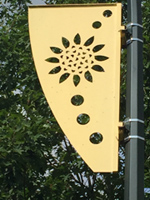 |
Vancouver |
British Columbia |
Canada |
Sculpture/Artwork |
Dial 990 |
| This artwork along Prince Edward street stretches about 1.5 mile (2.4 km). The latitude and longitude are given for the mid point. As public art the installation is know as Solar Patterns I and II. They are a collection of metal banners attached high on street poles and at eye level, an explanation of the pattern in the banner. Each banner consists of a yellow or orange aluminum sheet perforated with round holes representing the sun following a simple curve that is part of the analemma. The third dot from the top of the banner is replaced by an image of the sun as conceived by various artists ranging from school children to iconic images from various cultures to historic representations of the sun from cave paintings. |
| |
| |
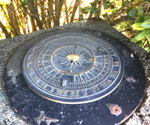 |
Lake Cowichan |
British Columbia |
Canada |
Horizontal Dial |
Dial 989 |
| This is a beautiful but standard mass-produced dial, with chapter rings for Roman numerals, hour lines, half and quarter hour lines. In the center is the sun surrounded by a compass rose, The dial itself is brass, but sits on a round cast iron base all sitting on a square concrete pillar. The gnomon was vandalized and now is missing. The base is losing its protective coat of paint and starting to rust. A thick hedge has grown up around the sundial, obscuring the sun on the east, south and west sides. It appears to be largely ignored. |
| |
| |
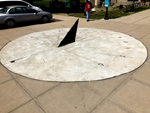 |
Fort Wayne |
Indiana |
USA |
Horizontal Dial |
Dial 988 |
| This is a large 20 foot diameter horizontal dial embedded in the cement sidewalk. Brass hour lines extend from the edge of the circular dial to the toe of the gnomon. The gnomon itself is a brass triangle, tarnished except for its tip that is frequently rubbed by visitors. Arabic numerals mark time by hours from 6 am to 6 pm. |
| |
| |
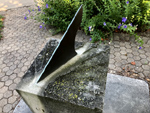 |
Fort Wayne |
Indiana |
USA |
Horizontal Dial |
Dial 987 |
| This horizontal dial is 16 inches square, made of limestone with a brass gnomon. The gnomon angle is 30 deg, certainly not correct for the dial's latitude of 41 deg. Nonetheless, it appears that the dial was made for its site as the gnomon and dial numbers are rotated on the square to point due north. Arabic numerals mark time by hours from 8 am to 6 pm, with raised hour lines extending toward the gnomon. The equation of time is shown as a graph on one side of the plinth. The limestone is deteriorating with age and is now covered with lichen. The 3 and 4 pm numbers are nearly obliterated and in several more years many of the other hour numbers will vanish. The dial is situated under trees with little opportunity to see the sun. |
| |
| |
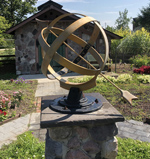 |
Fort Wayne |
Indiana |
USA |
Armillary Sphere |
Dial 986 |
| This is a 32 inch diameter armillary dial made of painted steel. The gnomon is a classic arrow at a 41 deg angle. The equatorial band is painted black with bronze colored Roman numerals indicate the hours from 6 AM to 6 PM. The dial is mounted on a field stone plinth. |
| |
| |
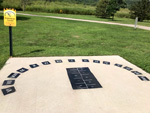 |
Houston |
Minnesota |
USA |
Analemmatic Dial |
Dial 985 |
| A simple analemmatic dial laid out in a square concrete base. The walkway and hour surrounds are black with white lettering. The hours are Roman numerals run from VI (morning) to VIII (evening). The dial is adjusted for daylight saving time and longitude such that when the sun is on the meridian, the dial shows about 6m after 1pm. |
| |
| |
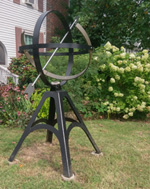 |
Webster Groves |
Missouri |
USA |
Armillary Sphere |
Dial 984 |
| The armillary sphere has three rings: (1) an equatorial time ring made of brass formed into an incomplete circular arc with a 36 inch inner diameter, a thickness of 1/2 inch, and width of 3 inches. Time markings in 15 minute intervals are inscribed on its inner surface with Arabic hour numbers; (2)a meridian ring made of steel formed into a circular arc 37 inches diameter, a thickness of 1/2 inch, and a width of 3 inches; and (3) a horizon ring made of steel into a circular arc 38 inches in diameter, with a thickness of 1/4 inch, and a width of 2 inches. The sundial is supported on a steel pedestal having an open square frustum construction. The gnomon is a steel rod having a pointed arrow tip aimed towards the North Celestial Pole. |
| |
| |
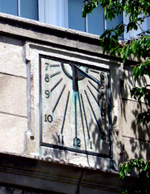 |
St. Louis |
Missouri |
USA |
Vertical Dial |
Dial 983 |
| The Mullanphy School is the last school of 48 designed by and constructed under the guidance of William B. Ittner (1864-1936), an architect and Commissioner of School Buildings for St. Louis, MO. Only hour lines are marked on this simple vertical sundial. The picture of the sundial was taken at 1:41 PM CDT on 7 May 2019. Using the relation T(solar) = T(civil) + EOT - Daylight - LonCorrection, with EOT=3.3m, Daylight=1h, and LonCorrection=1m, indicates that the dial should show 12:43:31. This suggests that Ittner’s sundial at the Mullanphy School displays this sundial time to a reasonable approximation, especially considering that its only time markings are hour lines. |
| |
| |
 |
Logan |
Ohio |
USA |
Analemmatic Dial |
Dial 982 |
| An analemmatic dial set in a gravel rectangle. It has a concrete walkway and circular hour markers in two ellipses for standard and daylight time. The hour numbers are adjusted for longitude, shifting them by 30 minutes (such that the due north line reads 12:30). |
| |
| |
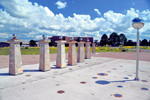 |
Magdalena |
New Mexico |
USA |
Obelisk or Vertical Gnomon |
Dial 981 |
| This vertical gnomon sundial sitting on a 46-by-35-foot concrete slab was constructed using concrete piers of a solar mapping radio telescope array that Robert Bracewell originally built near the Stanford University campus. The array was abandon in the 1980's. The 10 piers were moved to the VLA in 2013 and arranged as a vertical gnomonic dial. NASA: "As for most sundials the shadow cast by the central gnomon follows markers that show the solar time of day, along with solstices and equinoxes. But markers on the [Bracewell] radio sundial are also laid out according to local sidereal time. They show the position of the invisible radio shadows of three bright radio sources in Earth's sky, supernova remnant Cassiopeia A, active galaxy Cygnus A, and active galaxy Centaurus A." |
| |
| |
 |
Saskatoon |
Saskatchewan |
Canada |
Vertical Dial |
Dial 980 |
| It is a replacement for a south-facing vertical dial that was in the same location until the 1990s. It is approximately 4-foot wide by 12 -foot long. The gnomon is a metal rod held by four struts. The dial tells local solar time, showing Roman hours from 6am to 6pm. There is an elaborate Equation of Time graph and instructions for use at the bottom of the dial. At the top is latitude, longitude and elevation. |
| |
| |
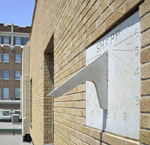 |
Joplin |
Missouri |
USA |
Vertical Dial |
Dial 979 |
| This is a simple but nicely engraved vertical sundial about 2-foot square made of concrete. The hour lines are delineated every half hour and marked on the hour in Arabic numbers. The gnomon is at least 1-inch thick, now epoxied into place. The hour lines converge correctly to the morning and afternoon toe of the gnomon, but no split noon hour line is seen. The dial is slightly recessed into the brick wall on the eastern edge correcting the Joplin street lay out of 1873 that used magnetic north that was 10 degrees east of north. |
| |
| |
 |
Stafford |
Virginia |
USA |
Vertical Dial |
Dial 978 |
| This vertical dial is 12 feet tall and nearly 20 feet wide. It is made of quarter-inch aluminum. The white hour lines running from 10am to 5pm are 4-inches wide. They run from the summer to winter solstice. The blue solstices and equinox line are quarter-inch aluminum 5-inches wide. The gnomon base is a yellow sun 10-inches in diameter with a 2-inch diameter gnomon. The nodus on the gnomon is a sphere 6-inches in diameter. |
| |
| |
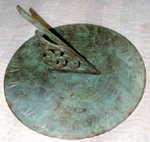 |
Richmond |
Virginia |
USA |
Horizontal Dial |
Dial 977 |
| A bronze dial 11.5 inches in diameter, 21 inches high. It is signed by Thomas Hart and dated 1765. The inscription on the dial implies a much later date of late 1800's or early 1900's. |
| |
| |
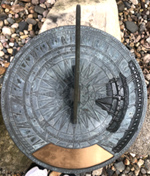 |
Des Moines |
Iowa |
USA |
Horizontal Dial |
Dial 976 |
| This is an ornate 12-inch diameter bronze horizontal dial with a central sun underneath the gnomon. Surrounding the the sun is an 8-point compass rose. On the chapter ring the hours are embossed from 5am to 7pm in Roman numerals that face outward. Time is delineated every 10 minutes. The gnomon is simple but too long for the dial, extending 2 inches past the dial edge. The place where a motto might be placed is empty, awaiting a bronze insert. |
| |
| |
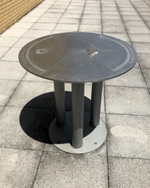 |
Des Moines |
Iowa |
USA |
Horizontal Dial |
Dial 975 |
| This is a 32-inch diameter horizontal dial made of stainless steel. Hour lines are engraved for every half hour and extend from summer to winter solstice based on the tip of the triangular gnomon. Hours are marked in Arabic numerals. Between the solstice limits are declination lines for the first of each month. Note that the inscribed latitude and longitude are slightly in error. |
| |
| |
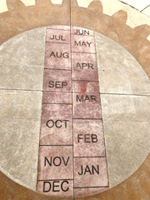 |
Rock Island |
Illinois |
USA |
Analemmatic Dial |
Dial 974 |
| This analemmatic dial is 20-foot wide within a 30-foot circle, all made of colored concrete. The Arabic dial hour markers follow an ellipse from 6 am to 6 pm. The dial is decorated with a botanical and Rotary Club theme. Gears and the Rotary 4-way test are interspersed with flowers and leaves of the four seasons. |
| |
| |
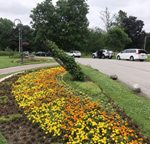 |
Davenport |
Iowa |
USA |
Horizontal Dial |
Dial 973 |
| This is a 40-foot diameter sundial made only from flowers. Hours are shown from 6am to 6pm. The gnomon is made of steel and wire mesh with sweet autumn clematis growing on it. The clematis vines are kept trimmed and tied up to keep the shadow from getting too big. The gardner commented, "If I were doing it over I would use a metal piece for the shadow finger." There is a steel frame in the ground to mark the outer edge and all the divisions of where to plant the plants inside the bed. The plants in the inner area of the sundial change from year to year – in 2019 it was two colors of marigolds. Alternanthera or Joseph’s Coat are used on the outer edge by the numbers. These flowers are sheared to keep them low and compact. The numbers are planted with green Alternanthera and surrounded by a band of red Alternanthera. These flower numbers are sheared with small electric grass shears and kept about 2 inches above the red band. Other plants in the sundial garden include large “elephant ears,” cactus-like agave, alyssum, ageratum and lime green and purple nicotiana. The purple nicotiana becomes fragrant after dark, providing an olfactory as well as a visual delight for visitors watching the lights play on the fountain. |
| |
| |
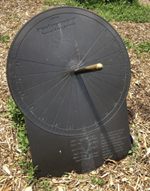 |
Denver |
Colorado |
USA |
Equatorial Dial |
Dial 972 |
| Bronze equatorial dial marking hours with Arabic numerals from 4:00 am to 8:30 pm for summer and from 5:00 am to 7 pm in winter. Additional marks indicate time in 15 minute and 5 minute intervals. Noon gap to choose gnomon shadow side. Hour lines marked from leading edge of shadow. The dial may be rotated by a hand wheel at bottom of the dial to adjust for both the equation of time and daylight savings time. |
| |
| |
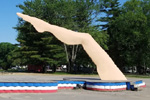 |
Roselawn |
Indiana |
USA |
Horizontal Dial |
Dial 971 |
| This dial consists of a fiberglass 18-foot high 36-foot gnomon in the shape of a bare tan-colored human leg. Hence the dial's name of "The Leg". The tip of the toe acts as a nodus. There are no hour lines and no declination lines. Instead, during summer months a series of hour markers are arranged on ground beneath the path of the nodus shadow. |
| |
| |
 |
Iowa City |
Iowa |
USA |
Equatorial Dial |
Dial 970 |
| An 2-foot diameter dial with a wide 8-inch equatorial band. Vertical lines mark half hours from 5 am to 7pm in Arabic numerals placed at both the top and bottom of the band. Zodiac declination with month and dates engraved. The shadow nodus is held in place by a horizontal rod. Time and date marks are faint, implying that the dial has been continually polished over the years. |
| |
| |
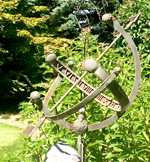 |
Summerland |
British Columbia |
Canada |
Equatorial Dial |
Dial 969 |
| This is a standard equatorial in reasonable condition, mass produced, probably steel, about 2 feet in diameter. As at 2019, it is loose on its base and so visitors are likely to find it out of alignment. It is mounted on a rough stone pedestal decorated with strips of metal reminiscent of plant foliage reaching up around it. |
| |
| |
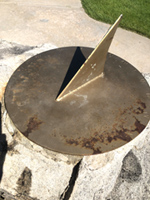 |
Sterling |
Colorado |
USA |
Horizontal Dial |
Dial 968 |
| This horizontal dial is 18 inches in diameter made of painted iron, and unfortunately parts of the dial face have rusted. The dial is marked hourly from 6am to 6pm to 6pm using Roman numerals at the dial circumference. Hour lines are made using a series of dots. The swept-wing design of gnomon has an angle of 42.5 deg, about 2 degrees higher than the latitude. The sundial sits on a sandstone boulder from Pawnee Pass, that was chosen by classmates for this memorial to honor Ken Malone who drown at North Sterling Reservoir. |
| |
| |
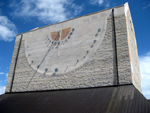 |
Denver |
Colorado |
USA |
Vertical Dial |
Dial 967 |
| This monumental size vertical dial consumes much of the south side of the Newman Center for the Performing Arts. The dial face is limestone and sandstone with disks standing out from the wall to mark the hours from 7am until 5pm. Two row of brass disks show the time: one circular set close to the gnomon for winter and another set at the circumference for summer. The size of the disks vary, growing in size from 7am to noon, then repeating the growing size from 1pm until 5pm. Roman numerals at 7, 12, and 5 show the hours. |
| |
| |
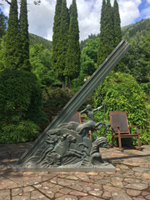 |
Nelson |
British Columbia |
Canada |
Horizontal Dial |
Dial 966 |
| The elegant bronze gnomon is 6 foot high with a modern interpretation of the zodiac sculptured into the lower half. The zodiac is represented by reliefs of Leo, Taurus, Pisces, Gemini, Virgo, and Sagittarius with his bow. The dial face is integrated into the plaza with a stainless steel chapter ring about 12 feet in diameter. The chapter ring has ornate grill work and Roman numerals to mark the hours. A small disk shows the Equation of Time correction in polar form with the months labelled along the circumference and EOT shown radially. The resulting graph looks somewhat like a kidney. |
| |
| |
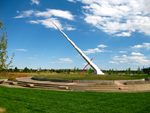 |
Denver |
Colorado |
USA |
Horizontal Dial |
Dial 965 |
| This monumental dial has a 58 foot tall gnomon made of aluminum cladding on a steel frame sitting on a concrete base. The surrounding elliptical walkway has red sandstone lines marking the time from 6 am to 6 pm. Time may be slightly off as the time lines do not account for the change in height between the walkway and the dial base. The markers south of the 6 o'clock lines are added only to provide artistic balance and do not mark time. |
| |
| |
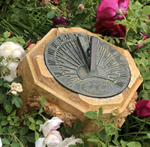 |
Denver |
Colorado |
USA |
Horizontal Dial |
Dial 964 |
| A 12 inch bronze horizontal dial marking quarter hours with Roman numerals.from 5 AM to 7 PM. The gnomon is about 1 1/2 inches wide and the hour lines are appropriately split at the noon marker. The dial sits on 3-foot stone plinth. |
| |
| |
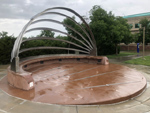 |
Aurora |
Colorado |
USA |
Gnomonic or Projection Dial |
Dial 963 |
| The Sun Shell is a band shell made of a series of six stainless steel arcs creating the illusion of longitude lines on a globe tilted so the poles are on the east-west horizon. A nodus is placed on one of the arcs that casts a point of light onto the floor of the band shell plaza. The floor is marked with Arabic numerals and stainless steel hour lines from 10 am to 3 pm. |
| |
| |
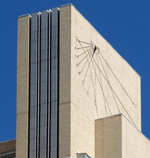 |
Denver |
Colorado |
USA |
Vertical Dial |
Dial 962 |
| A massive vertical dial, declining 48.08 degrees south of east, occupying the upper portion of the Arraj US Courthouse. Hours are marked from 5 am to 3 pm with Arabic numerals. The hour lines are crossed by declination lines for summer solstice, equinox, and winter solstice. |
| |
| |
 |
Owasso |
Oklahoma |
USA |
Analemmatic Dial |
Dial 961 |
| This is a nicely done 12 x 6 foot analemmatic. The time ellipse is white concrete with black hour marks using Roman numerals. Time is adjusted for longitude and daylight savings time. The walkway has black month marks and an explanation plaque. |
| |
| |
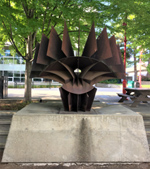 |
Kelowna |
British Columbia |
Canada |
Shadow Plane Dial |
Dial 960 |
| It is a large sculpture that acts as a shadow plane dial delineated at hourly intervals. The dial is about 3m high. It is made of mild steel with a concrete base, very precisely cut and installed. It shows local solar time, delineated at hourly intervals. Each shadow plane projects onto a small vane that has notches cut out, the number of notches indicating the hour. This dial is one of the earlier artworks by Alan Storey, a successful Canadian sculptor specializing in large-scale public art. The setting is a pleasant tree-lined courtyard at the center of the campus. in the years since the courtyard was laid out and the dial installed, the trees have grown large and cast shade on the dial. The best time to view the dial in sun is probably mid-morning, or in the winter when deciduous trees have lost their leaves. |
| |
| |
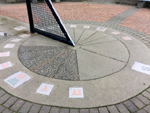 |
Kamloops |
British Columbia |
Canada |
Horizontal Dial |
Dial 959 |
| A simple horizontal dial consisting of a 6' gnomon made of black-painted steel tubes set in a circular concrete patio.The dial is located in a pleasantly laid out xeno garden (planted for arid conditions) with benches and a pergola. A riverside walk passes close by, and the whole area is designated for recreational and sports use. The gnomon is unusual for its plain industrial feel, and the use of wire mesh to fill in the gnomon's triangular substyle area. As well, the north end of the gnomon is formed by a pole that extends an extra 6' upwards, topped off by a weather vane. |
| |
| |
 |
Denver |
Colorado |
USA |
Noon Mark or Meridian Dial |
Dial 958 |
| Description, a 1-inch stainless steel line set in the granite pavement marks the location of the 105th meridian in front of Union Station. The meridian line marks the center of the time zone called Mountain Time, and is 7 time zones "earlier" the Greenwich. MT = UTC - 7. Throughout the Denver metro area, Kalamath Street is the road that most closely corresponds to the 105th meridian. The current 105th meridian would have been known as the 30th meridian of the United States in the 18th and 19th century. |
| |
| |
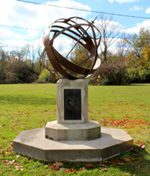 |
Indianapolis |
Indiana |
USA |
Armillary Sphere |
Dial 957 |
| This armillary is constructed adjacent to the original American Legion Wayne Post 64 building. It is made of iron with iron hour markers in Roman numerals on the equatorial band. It has arctic and antarctic circles and a longitude band from 6am to 6pm. The 45-inch diameter sphere sits atop a plain but elegant white square pedestal and octagonal dais. On the side of the pedestal are black marble plaques etched with the symbols of the Army, Navy, and Air Force. On the fourth side is the seal of the United States. |
| |
| |
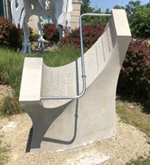 |
Fort Wayne |
Indiana |
USA |
Equatorial Dial |
Dial 956 |
| According to WPTA-21 news, "This odd looking nine thousand pound chunk of limestone is a scientific instrument, a sundial unlike any you’ve seen." It is an equatorial dial but with a parabolic shaped equatorial for telling time. The reason for the odd shape? "The shadow cast by a stainless steel bar moves across the dial face telling time not just in Fort Wayne but also half a world away in Takaoka, Japan, one of Fort Wayne’s Sister Cities. A half-size version of the same sundial in Takaoka does the same thing." |
| |
| |
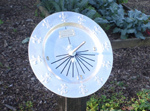 |
La Grange |
Kentucky |
USA |
Equatorial Dial |
Dial 955 |
| This equatorial dial is improvised using a 13 inch diameter aluminum plate embossed with fleur de lis around the perimeter. Hour lines run from 6am to 6pm with Arabic markers only at 12 and the 6's. |
| |
| |
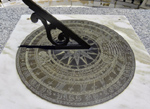 |
Saratoga Springs |
New York |
USA |
Horizontal Dial |
Dial 954 |
| The beautifully engraved horizontal dial plate is a reproduction of the original 1901 dial. It is inscribed with “Lat 43 degrees 5 N, Long. 73 degrees 46.40 W.” This is at slight variance from the current GPS position, implying that the dial has been moved from its original position. The dial plate is 18 inches in diameter and the gnomon has a vertical height of 8.5 inches. The gnomon and dial plate are aligned at 12 degrees west of true north. Significantly, the compass magnetic declination for this location is 13.5 degrees west of true north. This misalignment makes the dial about 30 minutes fast. This is particularly unfortunate since the inscribed dial is capable of showing time to the nearest minute. The stone table upon which the sundial rests is a reproduction of a table found in the ruins of Pompeii. |
| |
| |
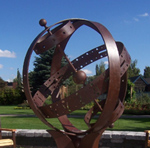 |
Calgary |
Alberta |
Canada |
Armillary Sphere |
Dial 953 |
| This large armillary sphere stands about 2m tall and 1.5m wide. The dial is marked by roman numerals etched completely through the equatorial band. Large holes form the hour moment, with smaller holes for the half and quarter hours. The meridian ring also serves as support for the dial. In addition are the arctic and antarctic rings. The design of a slot mechanism allows the equatorial ring to be rotated by 15° for Daylight Saving Time. However there is no plaque for the Equation of Time correction to civil time. |
| |
| |
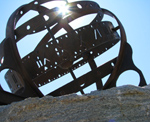 |
Summerland |
British Columbia |
Canada |
Armillary Sphere |
Dial 952 |
| A steel patinaed armillary sphere about 1.5m in diameter, mounted on a low boulder. The dial is marked by roman numerals etched completely through the thick equatorial band. Large holes form the hour moment, with smaller holes for the half and quarter hours. The meridian ring also serves as support for the dial. In addition are arctic and antarctic rings. A ball at the center of the dial has outlines of the continents, reflecting its status as a representation of the Earth at the center of the celestial sphere. The design of a slot mechanism allows the equatorial ring to be rotated by 15° for Daylight Saving Time. A simple Equation of Time plaque attached the boulder has explanatory notes allows correction to civil time. |
| |
| |
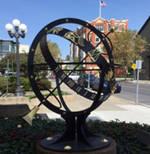 |
Saratoga Springs |
New York |
USA |
Armillary Sphere |
Dial 951 |
| Beautiful iron armillary sundial about 6 feet high. Painted black it has gold Roman numeral hours on the equatorial time band. On the outside of the equatorial band are the twelve zodiac motifs and stars are on the meridian band. The gnomon deviates from the classic arrow, having a gold flange at the base and a spiked orb at the north end. |
| |
| |
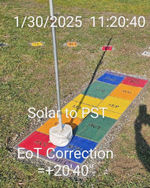 |
Woodland |
California |
USA |
Analemmatic Dial |
Dial 950 |
| This colorful analemmatic dial is an opening of the garden path made of decomposed granite. The sundial is 18 feet wide in the E-W direction and just a bit more than 9 feet in the N-S direction. Tile hour marks go from 6am to 7pm, with an additional tile above the 12-noon saying "PST" (Pacific Standard Time). Since there is no longitude correction, the sundial actually shows local solar time. But a nearby plaque with the Equation of Time allows the user to determine true civil time. Bailey Points for showing the direction of sunrise and sunset are planned The central walkway is made of colorful tiles, with each tile representing one month that is clearly labeled. |
| |
| |
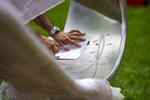 |
Providence |
Rhode Island |
USA |
Noon Mark or Meridian Dial |
Dial 949 |
| At first glance this is a gleaming stainless steel sculpture 15 feet long by 4 feet high in the shape of a Mobius strip. Although it fits its name "Infinity Possibility", it also contains a meridian noon mark sundial. At the south end of the Mobius, high up on its curved surface is a hole to allow the noontime sun to create a beam of light that hits a lower portion of the Mobius strip. Engraved on the strip is an analemma adjusted for the longitude of Brown University that shows date and civil time throughout the year. The analemma has monthly markers and is delineated with ticks every 5 days. |
| |
| |
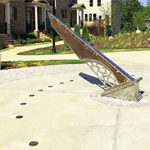 |
Kennesaw |
Georgia |
USA |
Horizontal Dial |
Dial 948 |
| Developers of Kennesaw Gateway Park, a new group of townhouses within walking distance of of town center, collaborated with Kennesaw State University (KSU) to design and fabricate a 9-foot tall horizontal sundial that has been placed in the circular plaza of the housing common area. Page Burch, a lecturer of KSU's Master Craftsman Program was the lead coordinator to design and fabricate the sundial gnomon. The stainless steel gnomon has a brass veneer and an unusual tilted based that nevertheless results in the the gnomon angle of 34 degrees exactly correct for the site latitude. |
| |
| |
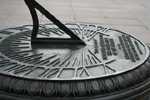 |
Columbus |
Ohio |
USA |
Horizontal Dial |
Dial 947 |
| This is one of a series of bronze sundials presented by Daughters of Union Veterans of the Civil War, dedicated to the memory of the Grand Army of the Republic. This dial is 24 inches in diameter, with an ornate design of ovals at the exterior, sloping down to 30 inches in diameter. Hours are marked from 5am to 7pm in Roman numerals. Time is marked in quarter hours. The gnomon is a simple open triangle. |
| |
| |
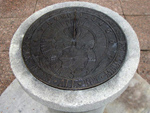 |
Columbus |
Ohio |
USA |
Horizontal Dial |
Dial 946 |
| This brass dial is a replica of the sundial installed at Mt. Vernon. It is about 12 inches in diameter with an offset eight point compass rose. The chapter ring has hour marks from 5am to 7pm in Arabic numerals. Hours are divided into quarter hours. Unfortunately the gnomon is broken off leaving only the lower third. |
| |